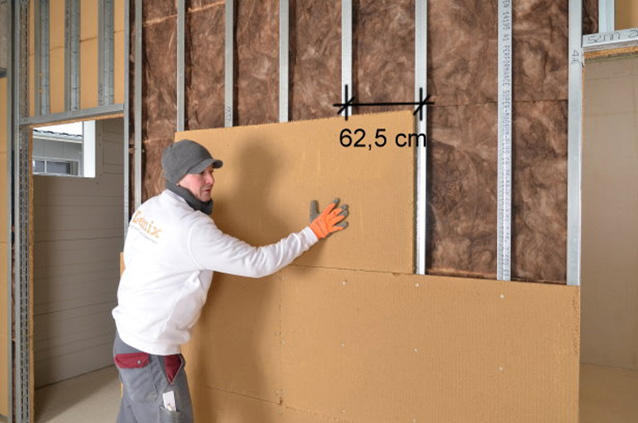
Lemix - clay plate

Description

Lemix advantages:
- Easy to install;
- Good acoustic insulation characteristics;
- Good microclimate features;
- Regulates the air humidity and is immune to mold;
- Ideal heat accumulator and regulator;
- Protection against electromagnetic radiation;
- Easy to process profiled surface;
- High dimension accuracy.
Technical Specification
| Board size | 62,5 x 125 cm | |
| Board thickness | 16 mm | 22 mm |
| Board weight | 18 kg | 25 kg |
| Package | 60 units (46,9 m2) | 40 units (31,2 m2) |
| Precision | Lenght x Width < +/- 2 mm Thickness < +/- 1 mm |
|
| Density | 1450 kg/m3 | |
| Thermal conductivity | λ (Lambda)= 0,59 W/mK | |
| Temperature class | Nonflammable (A1) | |
| Vapor permeability | μ = 5 / 10 | |
| Sound insulation | 51 dB | |
| Article | 17 000 0016 | 17 000 0022 |
| Thermal resistance | 1 kJ/kg*K | |
Fastening
Distance between wooden or metal support constructions:
- 62.50 cm, when board thickness is 22 mm;
- 31.25 cm, when board thickness is 16 mm.
Elements used for fastening:
- When using stainless steel bolts – 5 x 50 mm bolts with nuts;
- When staples are used – staple width - 26 mm, lenght - 45 – 65 mm.
At least 12 mounting points, at least 2 cm spaced between them.

Distance between wooden or metal support constructions:
- 31.25 cm, when board thickness is 16/22 mm.
Elements used for fastening:
- When using stainless steel bolts – 5 x 50 mm bolts with nuts.
At least 16 mounting points, at least 2 cm spaced between them.

Preparation
The Lemix clay building board can be cut using either a jig-saw, hand-held circular sawwith fine-toothed diamond tipped blade, or using an oscillating cutting machine. We recommend that you connect the vacuum cleaner to the tool and use safety glasses and respirators. Lemix clay decoration can also be cut with a simple construction knife, in this case it is necessary to fix well the cutting board. When cutting the board with a knife, an straight tool is used to maintain the straight cutting line.
Mounting
Building boards are always mounted with staggered joints: vertical joints should not be arranged above one another (horizontal joints likewise when the boards are mounted vertically). The boards should be staggered by at least 25 cm. TžIt is necessary to use bolts with nuts, when mounted on ceilings or roof structures. Due to its moisture-proof, the Lemix clayboards are perfectly suited for the bathroom. It must be fixed with stainless steel bolts. The board is not resistant to the direct impact of the water, so the it can not be used in places where tiles have to be used.
Lemix clayboards can be finished immediately after fixing. It is recommended to use clay plaster. The areas along the board joints are wetted with a fine spray of water. The flex textile mesh of the reinforcement tape (width 10 cm / mesh size 4-7 mm) is then applied to the still wet surface and fixed in place by brushing over with a slurry of fine-finish plaster. Tinplate is used by moving it forward and backward in a horizontal direction so that the plaster is distributed evenly and completely on the mesh. After plaster gets dry the joints are sanded with a sander, to ensure a smooth wall.



Preparing the wall
- Openings for recessed electrical socket boxes can be cut with a conventional core drill. For better stability when boring several adjacent sockets, mount a pre-drilled strip of plywood on the reverse side of the clayboard.;
- Before any subsequent layers are applied, the slurry or plaster mortar used to bed the reinforcement mesh must be fully dry. The entire surface is then carefully wetted. This prolongs the working time and improves the adhesion of the subsequent thin coat of fine-finish plaster. The application thickness of clay fine-finish topcoat plaster is 2-3 mm;
- Pictures, shelves and the like can be fixed with screws and wall plugs (e.g. cavity anchors). For heavy loads such as radiators, hanging cupboards etc., a horizontal board or scantling can be integrated into the wall construction as a supporting construction..







